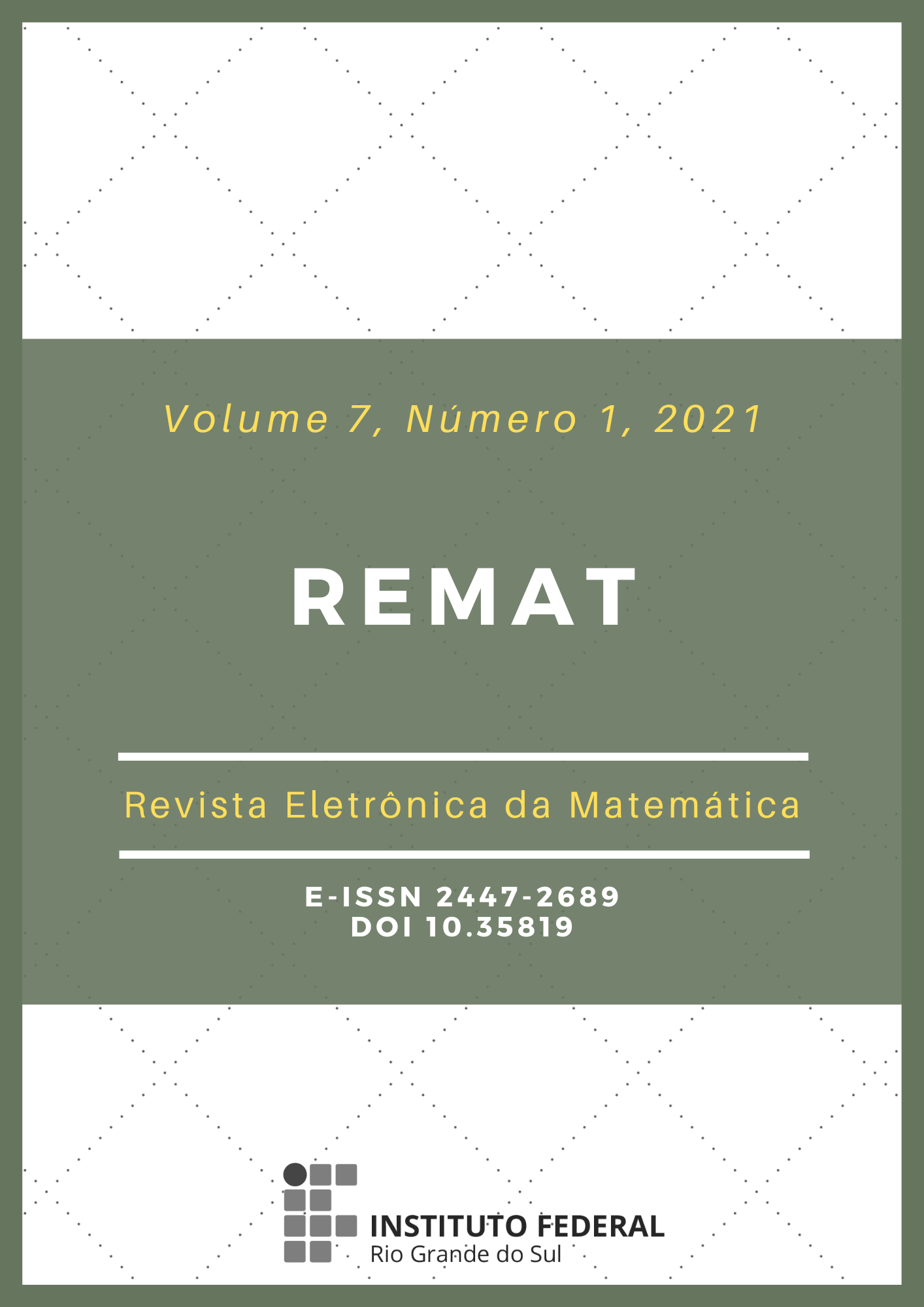Ensino de transformações de funções com GeoGebra: O caso de parabolóides definidos por g(x,y)=a(x-h)^2+b(y-k)^2+c
DOI:
https://doi.org/10.35819/remat2021v7i1id4075Keywords:
Transformações, Função de Duas Variáveis, Parabolóide Circular, GeoGebraAbstract
O artigo tem como objetivo descrever uma sequência para o ensino das transformações deformação, reflexão e translação em famílias de paraboloides circulares definidos por g(x,y)=a(x-h)2+b(y-k)2+c, através do GeoGebra. Essa sequência é estruturada em quatro momentos em que se procura: (i) definir os intervalos de variação de cada parâmetro em g, e (ii) visualizar e caracterizar as famílias de parabolóides de g(x,y), gerados após a variação de cada parâmetro no intervalo correspondente. Consideramos que a aplicação da sequência contribui para o desenvolvimento de habilidades e competências para coordenar as representações algébricas e geométricas das funções de duas variáveis, como é o caso da função discutida aqui. Por fim, consideramos que esta proposta pode aprimorar a prática dos professores de Matemática com interesse no uso de tecnologias digitais.
Downloads
References
BASURTO, E. Creando certeza en las ideas matemáticas vía el uso de tecnología digital. Cuadernos de Investigación y Formación en Educación Matemática, Costa Rica, v. 11, n. 15, p. 349-360, 2016. Disponible: https://core.ac.uk/download/pdf/129741799.pdf. Consultado en: 25 dic. 2020.
BASURTO, E.; GALLARDO, A. El estudio de los parámetros por medio de tecnologías híbridas. In: RODRÍGUEZ, M. M.; GARCÍA, G. F.; BLANCO NIETO, L. J.; MEDINA, M. M. P. Investigación en Educación Matemática XV. Ciudad Real, España: SEIEM, 2011. p. 287-296.
BASURTO, E. Uso de tecnología digital en la comprensión de parámetros en funciones polinomiales. In: RAMIREZ, A.; MORALES, Y. CONGRESO DE EDUCACIÓN MATEMÁTICA DE AMÉRICA CENTRAL Y EL CARIBE, 1., Santo Domingo, República Dominicana, nov. 2013. Memorias [...]. Pontificia Universidad Católica Madre y Maestra: 2013. Disponible: https://redumate.org/wp-content/uploads/2020/09/Memorias_completo.pdf. Consultado en: 25 dic. 2020.
BAYAZIT, ?.; AKSOY, Y. Connecting Representations and Mathematical Ideas with GeoGebra. Geogebra International Journal of Romania, v. 1, n. 1, p. 93-106, 2010.
BORBA, M. Computadores, Representações Múltiplas e a Construção de Idéias Matemáticas. Bolema, Rio Claro, v. 9, n. especial 3, 1994. Disponible: https://www.periodicos.rc.biblioteca.unesp.br/index.php/bolema/article/view/10799. Consultado en: 25 dic. 2020.
BORBA, M.; VILLARREAL, M. E. Experimentation, visualization and media in action. In: BORBA, M.; VILLARREAL, M. E. Humans-with-Media and the Reorganization of Mathematical Thinking. USA: Springer, 2005a. p. 125-167.
BORBA, M.; VILLARREAL, M. E. Visualization, mathematics education and computer environments. In: BORBA, M. C.; VILLARREAL, M. E. Humans-with-Media and the Reorganization of Mathematical Thinking. USA: Springer, 2005b. p. 79-99.
CASTILLO, L. A.; GUTIÉRREZ, R. E.; PRIETO, J. L. Una perspectiva de análisis de las transformaciones geométricas en curvas de la función f(x)=e^ax utilizando el GeoGebra. Revista do Instituto GeoGebra de São Paulo, v. 2, n. 2, p. 81-92, 2013. Disponible: https://revistas.pucsp.br/index.php/IGISP/article/view/17975. Consultado en: 25 dic. 2020.
CASTILLO, L. A.; PRIETO, J. L. El uso de comandos y guiones en la elaboración de simuladores con GeoGebra. UNIÓN, n. 52, p. 250-262, abr. 2018. Disponible: http://www.fisem.org/www/union/revistas/2018/52/aula1.pdf. Consultado en: 25 dic. 2020.
CONFREY, J.; SMITH, E. A framework for functions: Prototypes, multiple representations and transformations. In: UNDERHILL, R. G. NORTH AMERICAN CHAPTER OF THE INTERNATIONAL GROUP FOR THE PSYCHOLOGY OF MATHEMATICS EDUCATION, 13., Blacksburg, Virginia, oct. 1991. Proceedings [...]. Christiansburg Printing Company, 1991.
GUTIÉRREZ, R. E.; PRIETO, J. L. Deformación y reflexión de funciones con GeoGebra. El caso de las parábolas definidas por la expresión g(x)=ax^2. Números: Revista de didáctica de las matemáticas, v. 88, p. 115-126, mar. 2015.
HERNÁNDEZ, R. V.; FRANCISCO, U.; SANTANDER, D. P. Errores matemáticos en el conocimiento procedimental al resolver problemas de superficies cuadráticas. Revista Logos Ciencia & Tecnología, v. 8, n. 1, p. 67-76, jul./dic. 2016. DOI: https://doi.org/10.22335/rlct.v8i1.348.
HOHENWARTER, M.; HOHENWARTER, J.; KREIS, Y.; LAVICZA, Z. Teaching and calculus with free dynamic mathematics software GeoGebra. INTERNATIONAL CONGRESS ON MATHEMATICAL EDUCATION, 11., Monterrey, Mexico, jul. 2008. Proceedings [...]. Mexico, 2008.
HOHENWARTER, M.; PREINER, J. Dynamic mathematics with GeoGebra. Journal of Online Mathematics and its Applications, mar. 2007.
LARSON, R. Shifting Graphs. In: Precalculus. 8. ed. United States of America: Cengage Learning, 2010, p. 73-82.
LÓPEZ, J.; SOSA, L. Dificultades conceptuales y procedimentales en el aprendizaje de funciones en estudiantes de bachillerato. In: LESTÓN, P. Acta Latinoamericana de Matemática Educativa 21, 2008.
LOZANO, M. E. D.; HAYE, E. E.; MONTENEGRO, F.; CÓRDOBA, L. Dificultades de los alumnos para articular representaciones gráficas y algebraicas de funciones lineales y cuadráticas. In: RAMIREZ, A.; MORALES, Y. CONGRESO DE EDUCACIÓN MATEMÁTICA DE AMÉRICA CENTRAL Y EL CARIBE, 1., Santo Domingo, República Dominicana, nov. 2013. Memorias [...]. Pontificia Universidad Católica Madre y Maestra: 2013. Disponible: https://redumate.org/wp-content/uploads/2020/09/Memorias_completo.pdf. Consultado en: 25 dez. 2020.
REZENDE, W. M.; PESCO, D. U.; BORTOLOSSI, H. J. Explorando aspectos dinâmicos no ensino de funções reais com recursos do GeoGebra. Revista do Instituto GeoGebra Internacional de São Paulo, v. 1, n. 1, p. 74-89, 2012. Disponible: https://revistas.pucsp.br/index.php/IGISP/article/view/8370. Consultado en: 25 dez. 2020.
Downloads
Published
Issue
Section
License
Copyright (c) 2021 REMAT: Revista Eletrônica da Matemática

This work is licensed under a Creative Commons Attribution 4.0 International License.
REMAT retains the copyright of published articles, having the right to first publication of the work, mention of first publication in the journal in other published media and distribution of parts or of the work as a whole in order to promote the magazine.
This is an open access journal, which means that all content is available free of charge, at no cost to the user or his institution. Users are permitted to read, download, copy, distribute, print, search or link the full texts of the articles, or use them for any other legal purpose, without requesting prior permission from the magazine or the author. This statement is in accordance with the BOAI definition of open access.













 https://orcid.org/0000-0002-0893-7426
https://orcid.org/0000-0002-0893-7426


















